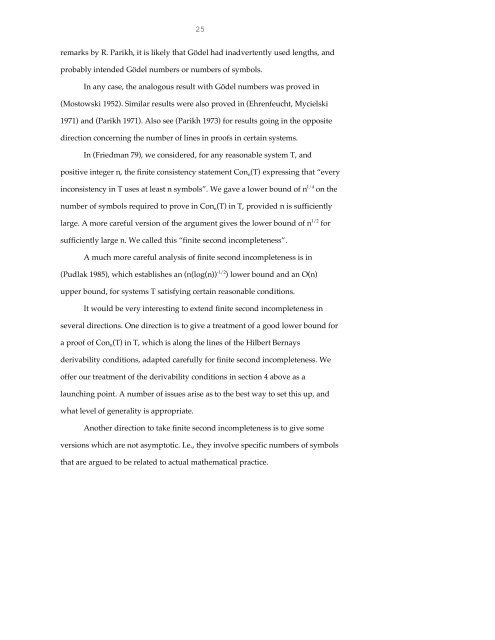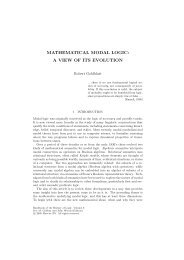my forty years on his shoulders - Department of Mathematics
my forty years on his shoulders - Department of Mathematics
my forty years on his shoulders - Department of Mathematics
- No tags were found...
Create successful ePaper yourself
Turn your PDF publications into a flip-book with our unique Google optimized e-Paper software.
25remarks by R. Parikh, it is likely that Gödel had inadvertently used lengths, andprobably intended Gödel numbers or numbers <strong>of</strong> symbols.In any case, the analogous result with Gödel numbers was proved in(Mostowski 1952). Similar results were also proved in (Ehrenfeucht, Mycielski1971) and (Parikh 1971). Also see (Parikh 1973) for results going in the oppositedirecti<strong>on</strong> c<strong>on</strong>cerning the number <strong>of</strong> lines in pro<strong>of</strong>s in certain systems.In (Friedman 79), we c<strong>on</strong>sidered, for any reas<strong>on</strong>able system T, andpositive integer n, the finite c<strong>on</strong>sistency statement C<strong>on</strong> n (T) expressing that “everyinc<strong>on</strong>sistency in T uses at least n symbols”. We gave a lower bound <strong>of</strong> n 1/4 <strong>on</strong> thenumber <strong>of</strong> symbols required to prove in C<strong>on</strong> n (T) in T, provided n is sufficientlylarge. A more careful versi<strong>on</strong> <strong>of</strong> the argument gives the lower bound <strong>of</strong> n 1/2 forsufficiently large n. We called t<strong>his</strong> “finite sec<strong>on</strong>d incompleteness”.A much more careful analysis <strong>of</strong> finite sec<strong>on</strong>d incompleteness is in(Pudlak 1985), which establishes an (n(log(n)) -1/2 ) lower bound and an O(n)upper bound, for systems T satisfying certain reas<strong>on</strong>able c<strong>on</strong>diti<strong>on</strong>s.It would be very interesting to extend finite sec<strong>on</strong>d incompleteness inseveral directi<strong>on</strong>s. One directi<strong>on</strong> is to give a treatment <strong>of</strong> a good lower bound fora pro<strong>of</strong> <strong>of</strong> C<strong>on</strong> n (T) in T, which is al<strong>on</strong>g the lines <strong>of</strong> the Hilbert Bernaysderivability c<strong>on</strong>diti<strong>on</strong>s, adapted carefully for finite sec<strong>on</strong>d incompleteness. We<strong>of</strong>fer our treatment <strong>of</strong> the derivability c<strong>on</strong>diti<strong>on</strong>s in secti<strong>on</strong> 4 above as alaunching point. A number <strong>of</strong> issues arise as to the best way to set t<strong>his</strong> up, andwhat level <strong>of</strong> generality is appropriate.Another directi<strong>on</strong> to take finite sec<strong>on</strong>d incompleteness is to give someversi<strong>on</strong>s which are not asymptotic. I.e., they involve specific numbers <strong>of</strong> symbolsthat are argued to be related to actual mathematical practice.
















